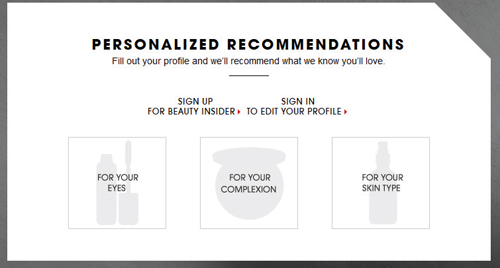Creepy vs. Cool & Other Personalization Mistakes

By Amberly Dressler, Managing Editor
Today's retailers have access to powerful platforms that can track, target and talk to individual shoppers - personalizing the shopping experience seamlessly across different online (and offline) channels.
There are myriad offerings available (for a list of popular personalization platforms visit wsm.co/retail1to1) to help ecommerce enterprises leverage customer attributes, behaviors and intent to make individual interactions more meaningful (and profitable), and many enterprises are eager to give the practice a try. In fact, 58 percent of senior marketing decision makers indicated they will be adding more personalized experiences in 2016 according to the CMO Council.
Marketers need to know that the user experience (and a brand's bottom line) can be negatively impacted when personalization efforts come off as more creepy than cool, however. So, what are the most common personalization mistakes?
Not Asking for Permission
Topping the list of common mistakes brands make in relation to personalization, according to RichRelevance CMO Diane Kegley, is the failure to enter into a partnership of sorts by asking consumers to opt in to the omnichannel experience (where info is tracked and leveraged regardless of device being used or channel being accessed) in exchange for some benefit.
While it's been well-reported that consumers are willing to give up some anonymity to receive an improved experience or direct benefit, consumers still want to be in control of who receives what. When it comes to permission-based personalization, retailers can simply ask users to identify themselves based on demographics, interests or other identifiers that will aid in more relevant messaging.
Giggle.com visitors, for instance, can register for the site with just an email and a password with the option to fill out their profiles more completely later on. The retailer, however, does not explain that when a parent provides information about their child, they'll receive more and better personalized offers, search results and the like. For many, this could be a missed opportunity to get a higher percentage of completed profiles and increase conversions and engagement (e.g., a buy one, get one free offer for a customer who has indicated she is expecting twins).

With a focus on transparency, a better example of permission-based personalization comes from Sephora in that the beauty brand states how it will use the information provided - to recommend products that fit that person's style profile. According to Adobe, Sephora's loyalty program, Beauty Insider, enables the brand to convert anonymous visitors to recognizable entities.

Adobe writes, "When a customer becomes part of the Beauty Insider program, a profile is created that can be accessed through mobile and desktop devices and through the iPad located at counters throughout its stores. This connectivity enables Sephora to link, for example, a customer's skin tone with products for sale within the store."
Did You Know?
+ Barneys has shown that customers who interact with personalized content convert at double the rate of its site average.
+ Shoppers who type products into the site search box convert 10 times more than other online visitors.
(Source: RichRelevance)
Using a Fragmented Customer View
Brands must first establish this consumer "partnership," and then they need the technology to connect consumer actions in-store, on the Web and over the phone into a single consumer profile.
"Without this technology in place, shoppers struggle to understand why brands treat them like different people in each channel (and at every sales point)," said Kegley of RichRelevance. "If brands don't engage with the shopper to create the omnichannel experience and use a personalization platform to tie the experience together, both engagement and sales suffer."
Jason Fordham, vice president of strategic solutions at SmarterHQ, agrees that brands must understand the context of what their shoppers are doing - otherwise personalized messages can become intrusive. For example, after visiting a popular home good retailers' site, Fordham browsed five products and added the bundle to his cart, abandoned the site and ultimately bought the products in-store. Meanwhile, the brand sent him seven emails in 11 minutes including browse emails, cart abandonment and a mass audience message.
"This brand understood what I was doing on its site, but didn't understand the context of interactions," said Fordham. "If a brand doesn't understand the lifecycle of its customers it creates a less engaging experience and can be seen as over stepping boundaries."
Over-Personalization
While a fragmented customer view can be confusing to consumers who engage, research and shop across channels, an over-personalized experience can be downright creepy. This can happen when a brand focuses on everything that personalization can do, according to Kegley of RichRelevance, instead of the capabilities that matter most to a brand's unique customer base.
RichRelevance recently surveyed more than 1,000 consumers to understand what personalization is "Creepy vs. Cool" in the store. The survey found that consumers welcome personalized product, content and offers when they are ready to engage. They may not be ready for personalized messages the moment they walk in the door but they welcome it when it comes time to purchase.
"Cool" capabilities include scanning a product on a mobile device to see personalized product reviews and recommendations and location-based personalized product recommendations, promotions and coupons within the store.
"A related issue is finding the right balance between relevance and creepiness," said Kegley. "Shoppers are sensitive to being over-watched. The stakes are high: Brands that overstep risk a significant consumer backlash."
The Creepy & Cool Future
Although personalized product recommendations, specifically, have been around for quite some time (some companies dating back well over a decade), more advanced personalization has come to many of retailers' fundamental technology stack, which includes their ecommerce platform - indicating the importance of understanding users across all interactions. Moving forward, Fordham of SmarterHQ predicts there will be a more unified approach in online and offline sales channels and that brands will concentrate on timing the offline experience with desktop and mobile experiences.
"There is already a customer expectation that a brand knows how that customer is engaging, what their sentiment is, what their in-store responses look like and how it pertains to the digital experience," said Fordham.

Subscribe to Our Newsletter!
Latest in Marketing








